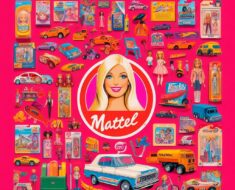Here is the story of Mr Potato Head, the iconic toy that has been entertaining generations of children and adults alike.
History
Mr Potato Head was born in 1949, when Brooklyn inventor and designer George Lerner came up with the idea of inserting small, pronged body and face parts into fruits and vegetables to create a “funny face man”. He got the inspiration from his wife’s nephew, who was seen placing sticks inside of potatoes in the family garden. Lerner would often take potatoes from his mother’s garden and, using various other fruits and vegetables as facial features, he would make dolls for his younger sisters to play with. The grape-eyed, carrot-nosed, potato-headed dolls became the principal idea behind the plastic toy that would later be manufactured.

However, Lerner faced some challenges in selling his idea to toy companies, as they were reluctant to use food as a toy, especially after the food rationing during World War II. He eventually sold his idea to a cereal company for $5,000, who would distribute his plastic parts as prizes in cereal boxes. But Lerner was not satisfied with this deal, as he believed his toy had more potential.
In 1951, he met the Hassenfeld Brothers, owners of a toy and school supply company in Rhode Island. They saw the great potential of Lerner’s toy and paid the cereal company $7,000 to stop production. They also gave Lerner $500 in advance and 5% royalties for every set sold. They named the toy Mr Potato Head and launched it in 1952.
Mr Potato Head was the first toy to be advertised on television, and the first to target children directly, rather than their parents. The commercial revolutionized marketing and caused an industrial boom. Over one million kits were sold in the first year. The original kit consisted of 28 plastic parts, such as eyes, noses, mouths, ears, hats, glasses, and a pipe, that could be attached to a real potato or other vegetable. The kit also came with a styrofoam head that children could use as an alternative.
In 1953, Mr Potato Head was joined by his wife, Mrs Potato Head, and soon after, their children, Yam and Spud, and their friends, Kate the Carrot, Pete the Pepper, Oscar the Orange, and Cookie Cucumber. The Potato Head family also expanded with accessories such as a car, a boat trailer, a kitchen set, a stroller, and pets.
Current
In 1964, due to complaints about rotting vegetables and new government safety regulations, Hasbro (the new name of the Hassenfeld Brothers company) decided to include a plastic potato body with the toy set, along with larger and safer parts. The plastic potato body had holes for the parts to fit in, and a compartment at the back to store them. The new design also allowed for more facial expressions and combinations.
Mr Potato Head became a cultural icon, appearing in various media and events. He was featured in comic books, board games, video games, and even a short-lived TV show in 1998. He also became a balloon in the annual Macy’s Thanksgiving Day Parade. He was inducted into the National Toy Hall of Fame in 2000.
But perhaps his most famous role was in the Toy Story franchise, produced by Pixar and released by Walt Disney Pictures. Mr Potato Head, voiced by Don Rickles, was one of the main characters in the animated films, along with his wife, Mrs Potato Head, voiced by Estelle Harris. He was a loyal friend to Woody, the toy cowboy, and a sarcastic and grumpy leader to the other toys. He also had the ability to detach and reattach his parts, and even use other objects as his body, such as a tortilla, a cucumber, and a piece of bread.
Future
The future of Potato Head is uncertain, as the toy industry faces many challenges and changes. Some of the factors that may affect the toy’s popularity and relevance are:
- The rise of digital and interactive toys, such as smartphones, tablets, and virtual reality, that may compete with or complement the traditional physical toys.
- The changing preferences and expectations of children and parents, who may demand more diversity, creativity, and personalization in their toys.
- The environmental and social impacts of toy production and consumption, such as plastic waste, carbon emissions, labor rights, and ethical sourcing.
- The legal and regulatory issues that may arise from the toy’s rebranding, such as trademark disputes, consumer complaints, and cultural sensitivities.
However, Potato Head may also have some opportunities and advantages, such as:
- The nostalgia and loyalty of the older generations, who grew up with the toy and may pass it on to their children and grandchildren.
- The innovation and adaptation of the toy, which may introduce new features, designs, and collaborations to attract new customers and markets.
- The educational and developmental benefits of the toy, which may foster children’s imagination, creativity, fine motor skills, and social skills.
- The entertainment and cultural value of the toy, which may continue to appear in various media and events, and even inspire new stories and characters.
Potato Head may not be the most popular or trendy toy in the market, but it has a long and rich history, and a loyal and diverse fan base. It has been entertaining and inspiring generations of children and adults alike, and it may continue to do so for many more years to come.






